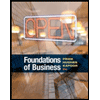
Case summary: Person DE was serving as the chief financial officer for a company REC. The company was a distributor of serving electricity in portions of North Dakota. Company REC was taking over company DGI that was distributing natural gas within North Dakota. DE went on a trip to fishing with his uncle EW. During the trip, DE told his uncle that he has been investing a lot of extra time in company REC as it was taking over the natural gas distributing company, DGI. P EW after returning from the trip purchased a stock of $20,000 in company REC. The value of stock rose by 72 percent that resulted in a profit of $14,400 at the time when EW sold his stock of REC.
To explain:The theories court will use to hold EW liable for insider trading.
Want to see the full answer?
Check out a sample textbook solution
- This question is regarding business negotiation BUS356 in SUSS. The case below is extracted from Harvard Business Review Case Study “Move Fast,but without Bias: Ethical AI Development in a Start-up Culture”. It is important to support your answers with specific examples based on thescenario given in the case study below to demonstrate your understanding andapplication of the relevant concepts. You may make reasonable assumptions, aspart of your analysis. Answers must be supported with theoretical models and concepts from therecommended textbook, Lewicki, R. J., Saunders, D. M. & Barry, B. (2021). Essentialsof Negotiation (7th ed). New York: McGraw-Hill International Edition and coursematerials. Please provide useful links and citations for learning purposes.arrow_forwardDelta Corporation has the following capital structure: Cost Weighted (after-tax) Weights Cost Debt 8.1% 35% 2.84% Preferred stock (Kp) 9.6 5 .48 Common equity (Ke) (retained earnings) 10.1 60 6.06 Weighted average cost of capital (Ka) 9.38% a. If the firm has $18 million in retained earnings, at what size capital structure will the firm run out of retained earnings? b. The 8.1 percent cost of…arrow_forwardWhat is the contribution margin per unit sold on these accounting question?arrow_forward
- Please given correct answer for General accounting question I need step by step explanationarrow_forwardDillon Enterprises has the following capDillon Enterprises has the following capital structure. Debt ........................ 40% Common equity ....... 60 The after-tax cost of debt is 6 percent, and the cost of common equity (in the form of retained earnings) is 13 percent. What is the firm’s weighted average cost of capital? a. An outside consultant has suggested that because debt is cheaper than equity, the firm should switch to a capital structure that is 50 percent debt and 50 percent equity. Under this new and more debt-oriented arrangement, the after-tax cost of debt is 7 percent, and the cost of common equity (in the form of retained earnings) is 15 percent. Recalculate the firm’s weighted average cost of capital. b. Which plan is optimal in terms of minimizing the weighted average cost of capital?arrow_forwardKindly help me with this General accounting questions not use chart gptarrow_forward
 Foundations of Business (MindTap Course List)MarketingISBN:9781337386920Author:William M. Pride, Robert J. Hughes, Jack R. KapoorPublisher:Cengage Learning
Foundations of Business (MindTap Course List)MarketingISBN:9781337386920Author:William M. Pride, Robert J. Hughes, Jack R. KapoorPublisher:Cengage Learning
